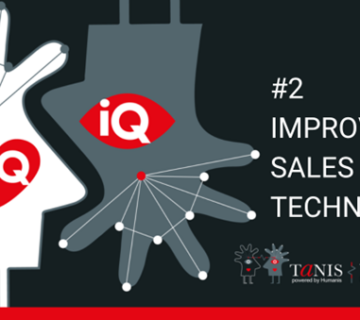You will probably wonder: What skills will the leaders in my organization need in the future?
A quick Google search will come up with skills we already know are required for leaders to work effectively. These include goal setting, people development, effective communication, etc.
But in today’s unpredictably changing business environment, are these skills enough to drive change? Are these skills the ones that will still be needed in the next few years?
According to Innovations International, there are two crucial competencies needed to create a “leading from the future” organization. A high-performance organization that is able to transform its structure and functioning and help employees address present and future changes, a FuturePerfect organization needs to transition from the Human potential to Technology intergration.
People within an organization will look to leaders to deal with and drive change. They are the ones who will have to prove able to foster a mindset of resilience and innovation while also guiding the rest of the people within the organization to adapt to it.
Of course, becoming a leader is a dynamic process that requires certain skills. The good news is that you can develop all of them.
Recent studies show that successful and capable business leaders are combining a range of relationship-oriented to task-oriented skills, including:
- Demonstrating Self-Mastery
- Mentoring and Coaching a Diverse Workforce
- Cultural Competency
- Influencing, Encouraging, and Developing the Competency of Others
- Problem and Conflict Resolution Across Employee Differences
- Holding Others Responsible and Accountable for Inclusion and Performance Expectations
- Creating a Culture of Creativity, Innovation, Quantum-Thinking
- Fostering an Environment of Cooperation, Collaboration, and Teamwork
We break down the list to help you understand each of these essential leadership skills. Read on to learn more.
Demonstrating Self-Mastery
The first step in leadership development is self-awareness. Identifying people’s leadership impact is critical to building rapport with their teams. Using Emotional Intelligence (EQ), leaders can become more aware of what motivates them and their decision-making.
They can discover strengths and possible limitations and how to manage them so that they can improve personal communication performance (personal transformation) and help move their team forward (business transformation).
Mentoring and Coaching a Diverse Workforce
Mentoring and coaching a diverse workforce means leaders should be able to create an open and transparent environment for their teams. Working with others in a mutually respectful, trusting, open, and supportive way is the only way to move forward and succeed as a leader today.
Leaders should look at leadership as a way to foster synergism, cooperation, and quantum-thinking among diverse people and teams. In this way, they can leverage the power of difference and create a high-performance organization.
Humanis recognized among the Top 10 Diversity & Inclusion service providers in Europe 2022
Do you want to learn more about leading with Diversity and Inclusion (D & I)? Click here
Cultural Competency
In today’s multicultural global working environments, it is important for leaders to be able to demonstrate cultural competency. What does this mean in practice? It means being aware of your own worldview and accepting the worldview of others.
During cross-cultural interactions, the way we experience any differences or conflicts impacts how we shape relationships among teams, and our ability for personal transformation.
Remember it is important for leaders to retain their authenticity, and show their understanding, sensitivity, and inclusive behaviors in cross-cultural behaviors.
Influencing, Encouraging, and Developing the Competency of Others
According to John Maxwell “Leadership is influence, nothing more, nothing less“. And we totally agree with this: Leaders need to use their positive power and influence to develop people, enhance working relationships, provide and coach new learning opportunities to a diversity of employees, and achieve business objectives. To do so, the first step for leaders is to become aware of their influence style; become conscious of what they say and how they say it, in order to reach their business goals and simutaneously, preserve their good working relationships with their team.
Only by understanding how current behaviors affect others, will help influence, encourage, and develop the competencies of others. This skill is also useful for managing and resolving problems and conflicts across employee differences and debates in the most positive and effective way.
Problem and Conflict Resolution Across Employee Differences
Problem-solving is another competitive skill that leaders should add to their array. But how do problem and conflict resolution make you a better leader?
Being able to identify the problem, set it apart from the person who is creating it, and generate – free from any unconscious bias – possible solutions, helps achieve better collaboration within the team. It helps guide your team towards the goals in a constructive way. Managing conflict effectively also helps create an environment of trust where team members can express their concerns, ideas, or different points of view openly. In this way, you ensure that the decision-making process is also effective.
Holding Others Responsible and Accountable for Inclusion and Performance Expectations
Responsibility and accountability go hand in hand with inclusion and performance. Leaders should be able to support their teams so as to ensure that they fulfill the expectations and accountabilities of their roles.
To do so, leaders need to identify these expectations and accountabilities in others and help create a clear development path for their employees. Being there to support them along the way and empower them to resolve any personal challenge regarding the fulfillment of their goals is key.
Holding others responsible and accountable for performance and results can be challenging when working with diverse teams, but leaders should strive for inclusion in order to achieve the best results.
Creating a Culture of Creativity, Innovation, Quantum-Thinking
How open are leaders to new ideas? How frequently do regular discussions with colleagues go beyond conventional thinking? How can one create an expanded culture of creativity within the organization?
The role of today’s leaders is to encourage critical thinking, out of the box ideas, and problem resolution. The ability to see beyond regular ideas, explore details and use it to transform information into knowledge is crucial. That’s where expanded creativity comes in: Quantum-thinking is the ability to envision future paradigms and creativity is the ability to move progressively across a paradigm. These two skills together are the basis for creating transformation to a team, product, service, process or an organization.
Fostering an Environment of Cooperation, Collaboration, and Teamwork
Being able to see interactions and events as an opportunity to have an open conversation, will help leaders shift their mindset and see them as a learning experience they can get the most of.
Working together as a team to reach a common goal or to reach a consensus, while balancing individualism and collaboration, leaders should be the ones to foster respect, trust, and mutual support among working relationships. This will lead to personal growth, increased engagement and improved team and business performance.
As we said at the beginning of this article, leaders or future leaders can develop these key skills.
Learn more about our game-changing training program “We transcend into 21st century leadership” which introduces A Holistic Model of Leadership for leading and managing a diverse, high-performance workforce.
Heading into 2023, are you ready to transform your leadership style?




